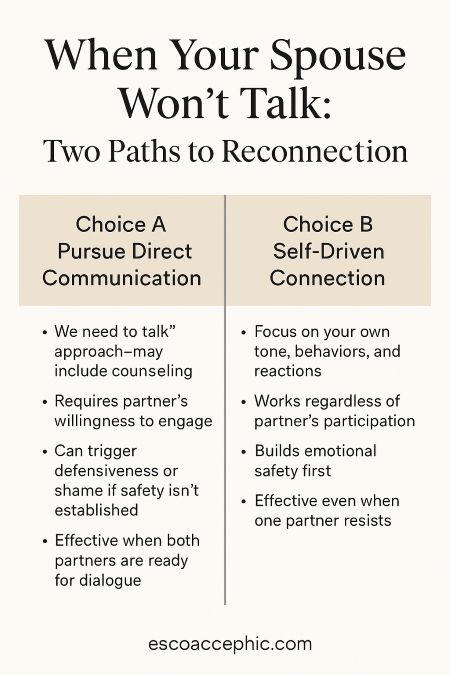
When a spouse won’t talk, some people try to open up the conversation right away, while others focus first on adjusting their own responses and behaviors to create a safer, calmer space for communication later.
A Story for You — Hope for When Your Spouse Won’t Talk
About a year ago I received a call from a woman who was interested in couples counseling. There was one problem: her husband refused to come to a marriage counseling. I gave her some pointers about how to help her husband become more amenable to coming and I even recommended a book.
A year later she called me and told me that although the book was helpful, he was still disinterested, and she was fed up.
I stressed that until her husband was ready, her only solution was to look at what she was bringing to the relationship and how she could be the best spouse she could be.
What Happened Next…
I also recommended a book entitled How to Improve Your Marriage Without Talking About it by Drs Patricia Love and Steven Stosny. While it seems this book would put me out of business, as much of what I do is teach couples how to talk about issues in a way that brings them to a closer connection, I thought this book would provide her with some insight into her relationship and help it improve given their inability to come to my office.
I was shocked when she called me a few weeks later and told me her that her marriage had drastically improved.
While they were still not ready for counseling, her marriage went from intolerable to better than ever almost overnight.
It’s about Fear and Shame
What great secret did this book reveal? One of the main contributions of the book is the theory that couples disconnect due to fear and shame. An example, men and women fear homelessness equally, though in different ways. If you were to ask a woman, her main fears would be harm, isolation, and deprivation. Most men would say that the most difficult part would be feeling like a failure. While safety may be an issue for men, the utter shame of being on the street, unemployed, etc… is the primary concern.
This gender distinction is key to establishing and maintaining connection in marriages.
Men must be conscious not to trigger their wives’ fears and women must be conscious not to shame their husbands.
This is especially challenging in communities where couples get married while they are still in school. Many of the men may not yet be gainfully employed or even have a career path. This can be very scary for women who are relying on their husband to support. At the same time it can be a shameful experience for men in that position. I have heard numerous stories of young couples where male shame is exacerbated by female fear around employment issues and vice versa. In fact, fear and shame become a cycle where her anxiety causes his shame and his shame causes her anxiety.
When couples come to see me, I often remind them to avoid blaming language in sessions. I will tell the “blaming” spouse- he really wants to hear what you have to say and understand you so that you can improve your connection. He is going to have a hard time if he feels he is being accused or criticized and will feel even more disconnected. Try sharing your feelings in a way where you take ownership.
The book gives countless examples of ways in which both men and women cause more disconnect in their relationship.
The authors also provide many suggestions for relating in a way that promotes connection, but I wouldn’t want to spoil the book for you by revealing them all.
When couples become aware of what triggers one another and learn how to relate they get into less fights and they make more room for positive energy in their relationship.
As the wife told me, “we fell in love again but now it is much deeper.” It is my hope that you will find How to improve your marriage without talking as helpful and transforming as that couple did!
When your spouse won’t talk to you on and off for extended amounts of time, those symptoms are indicative of a greater problem. Whether it’s due to a past childhood experience or just a lack of communication skills, this inability to communicate is indicative of a greater problem of disconnect. Your marriage needs to thrive or it will get worse and it’s important that it be cared for properly.
How to Improve Your Marriage Without Talking About It
The book’s core insight is this: disconnect often stems from fear and shame2. Women often feel threatened by fear (e.g., isolation, harm), while men frequently react when triggered by shame (e.g., failure, inadequacy)3. Misaligned emotional triggers can spiral—her anxiety triggers his shame, and his retreat triggers her fear.
By recognizing and gently avoiding these triggers, she began to relate in a way that soothed rather than provoked—and over time, the connection returned4.
Why This Works
When individuals feel unsafe—whether due to fear or shame—the brain’s threat system overrides rational listening7. This is why emotionally focused approaches, such as Imago, often prioritize emotional safety before deep dialogue8.
In relationships, especially in communities where couples marry young and may face financial uncertainty, these triggers are magnified. A husband’s job instability may fuel a wife’s fear, which in turn can deepen his shame9. The cycle continues unless one partner disrupts it.
Self-driven changes—adjusting tone, reducing blame, and offering reassurance—can create enough safety for connection to re-emerge10.
Key Takeaways
- Disconnect usually signals emotional threats—not just silence. Fear and shame are hidden drivers of withdrawal.
- Safety trumps dialogue. Lowering emotional arousal helps re-open the lines of communication.
- One partner’s change can shift the whole dynamic. Self-driven actions can be powerful even when your spouse isn’t participating.
- Research supports this indirect approach. EFT, neuroscience, and gender studies all highlight the importance of emotional safety before tackling hard conversations.
- Avoiding emotional triggers is strategic, not passive. It lays the groundwork for re-engagement.
Sources
Love, P., & Stosny, S. (2007). How to Improve Your Marriage Without Talking About It. Broadway Books. ↩
Sonderbooks. “How to Improve Your Marriage Without Talking About It – Review.” https://sonderbooks.com/blog/?p=35403 ↩
New Insights Counselling. “How Men and Women Experience Shame Differently.” https://www.newinsights.ca/how-men-and-women-experience-shame-differently/ ↩
Dan Metevier, PsyD. “Book Review: How to Improve Your Marriage Without Talking About It.” https://www.danmetevier.com/book-review-how-to-improve-your-marriage-without-talking-about-it/ ↩
Verywell Mind. “Understanding Gender Roles and Their Effect on Our Relationships.” https://www.verywellmind.com/understanding-gender-roles-and-their-effect-on-our-relationships-7499408 ↩
Gottman, J. (1999). The Seven Principles for Making Marriage Work. Crown Publishing. ↩
Porges, S. W. (2011). The Polyvagal Theory: Neurophysiological Foundations of Emotions, Attachment, Communication, and Self-Regulation. W. W. Norton & Company. ↩
Verywell Mind. “Emotionally Focused Therapy for Distressed Couples.” https://www.verywellmind.com/emotionally-focused-therapy-for-distressed-couples-2303813 ↩
Love & Stosny, 2007. ↩
Stosny, S. “Why You Can’t Change Your Partner.” Psychology Today. https://www.psychologytoday.com/us/blog/anger-in-the-age-entitlement/201305/why-you-cant-change-your-partner ↩
More inspiration to improve communication…
The most important thing for a healthy marriage (surprise: it’s not conflict resolution)
Bootcamp-style relationship therapy for couples
Affordable group marriage workshops to help improve communication
Why Surrendering in Your Marriage Builds Trust & Strengthens Your Relationship






